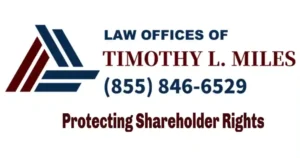Introduction to the Microstrategy Class Action Lawsuit
The MicroStrategy class action lawsuit seeks to represent purchasers or acquirers of MicroStrategy Incorporated d/b/a Strategy (NASDAQ: MSTR; STRK; STRF) securities between April 30, 2024 and April 4, 2025, inclusive (the “Class Period”). Captioned Hamza v. MicroStrategy Incorporated d/b/a Strategy, No. 25-cv-00861 (E.D. Va.), the MicroStrategy class action lawsuit charges MicroStrategy and certain of MicroStrategy’s top executives with violations of the Securities Exchange Act of 1934.
If you suffered substantial losses and wish to serve as lead plaintiff of the MicroStrategy class action lawsuit or just have general questions about you rights as a shareholder, please contact attorney Timothy L. Miles of the Law Offices of Timothy L. Miles, at no cost, by calling 855/846-6529 or via e-mail at [email protected].
Lead plaintiff motions for the MicroStrategy class action lawsuit must be filed with the court no later than July 15, 2025.
In this step-by-step comprehensive guide, you will learn everything you need to know about the lead plaintiff process in the MicroStrategy class action lawsuit.
Allegations in the MicroStrategy Class Action Lawsuit
Since 2020, MicroStrategy has increasingly focused on purchasing and holding bitcoin, a type of crypto-currency, as a long-term business strategy. According to the complaint, on January 1, 2025, MicroStrategy adopted the Financial Accounting Standards Board’s Accounting Standards Update No. 2023-08, Intangibles – Goodwill and Other – Crypto Assets (Subtopic 350-60): Accounting for and Disclosure of Crypto Assets (“ASU 2023-08”), which requires publicly traded companies to measure their crypto assets at fair value in their financial statements, with gains and losses from changes in the fair value of those assets recognized in net income in each reporting period.

The MicroStrategy lawsuit alleges that defendants throughout the Class Period made false and/or misleading statements and/or failed to disclose that:
- The anticipated profitability of MicroStrategy’s bitcoin-focused investment strategy and treasury operations was overstated; and
- The various risks associated with bitcoin’s volatility and the magnitude of losses MicroStrategy could recognize on the value of its digital assets following its adoption of ASU 2023-08 were understated.
The MicroStrategy lawsuit further alleges that on April 7, 2025, MicroStrategy disclosed that, following its adoption of ASU 2023-08, it recognized a $5.91 billion unrealized loss on its digital assets for the first quarter of 2025, which was expected to result in a net loss for the quarter.
As a result, MicroStrategy warned investors that “[w]e may not be able to regain profitability in future periods, particularly if we incur significant unrealized losses related to our digital assets,” according to the complaint.
The MicroStrategy class action lawsuit alleges that on this news, the price of MicroStrategy stock fell nearly 9%.
The Lead Plaintiff Process Under the Private Securities Litigation Reform Act of 1995
The Private Securities Litigation Reform Act (PSLRA) of 1995 was enacted to curb frivolous or unwarranted securities lawsuits and ensure that the interests of shareholders are adequately protected. One of the key components of the PSLRA is the lead plaintiff process, which is designed to identify and appoint the most suitable plaintiff to represent the class in securities class action lawsuits.
This process aims to ensure that the class members, typically investors who have suffered financial losses due to fraudulent activities or misrepresentations by a company, are represented by an individual or group with significant financial stakes in the case, thereby aligning their interests with those of the class.

In the context of a MicroStrategy class action lawsuit, for instance, shareholders who believe they have been defrauded would file a lawsuit against MicroStrategy Inc. The court would then publish a notice to inform potential class members about the lawsuit and their right to participate.
Within 60 days of this notice, any investor who wishes to serve as the lead plaintiff must file a motion with the court indicating their intent. The PSLRA presumes that the most adequate lead plaintiff is the one with the largest financial interest in the relief sought by the class, provided they meet certain legal requirements and can fairly and adequately represent the interests of the class.
Once all motions are filed, the court undertakes a thorough review process to evaluate each candidate’s suitability. The court considers factors such as the size of the potential lead plaintiff’s financial loss, their experience in similar litigation, and their ability to manage and oversee the litigation effectively.
In a MicroStrategy class action lawsuit, it is crucial that the selected lead plaintiff has substantial losses related to MicroStrategy stocks to ensure they have a strong incentive to pursue the lawsuit vigorously.
After appointing the lead plaintiff, this individual or group takes on significant responsibilities in managing the class action. They work closely with class counsel, oversee legal strategies, and make critical decisions on behalf of all class members. The lead plaintiff must also ensure that any settlements or resolutions are fair and equitable for all involved parties.
This role is pivotal in maintaining the integrity of the litigation process, ensuring that it serves the best interests of all shareholders affected by alleged securities fraud.
In conclusion, the lead plaintiff process under the PSLRA is an essential mechanism for fostering effective and fair representation in securities class action lawsuits. By designating plaintiffs with substantial financial interests and capabilities to manage complex litigation, this process aims to improve accountability and outcomes for defrauded investors.
In cases like a MicroStrategy lawsuit, having a competent and committed lead plaintiff can significantly influence the success of legal actions against corporate misconduct, ultimately protecting investors’ rights and enhancing market integrity.
The Lead Plaintiff Deadline in the MicroStrategy Class Action Lawsuit
Lead plaintiff motions for the MicroStrategy class action lawsuit must be filed with the court no later than July 15, 2025.
When a securities class action is filed:
- The person who files the first complaint is required to publish a notice announcing the filing.
- Anyone who wants to be the lead plaintiff on behalf of the class must thereafter file a motion to be appointed as lead plaintiff(s) no later than 60 days after the notice was published.
The Benefits of Serving as a Lead Plaintiff in the Vestis Lawsuit
- Negotiating more competitive attorney fees and reducing litigation costs.
- Managing the litigation by overseeing the progress of the case and reviewing important filings.
- Participating in mediation and settlement discussions.
- Having a voice in decision-making processes regarding the settlement.
- No financial risk, as lead counsel covers all costs and expenses and are paid only if they secure a settlement or judgment recovery for the class
- Potentially enjoying long-term benefits from governance reform resulting from the litigation.
The Responsibilities the Lead Plaintiff Will Have in the MicroStrategy Lawsuit
- Selecting, monitoring, and overseeing Lead Counsel.
- Reviewing and commenting on court filings on behalf of the class.
- Discussing litigation strategies with the Lead Counsel.
- Attending depositions (if necessary) and giving a deposition.
- Attending hearings (if necessary).
- Participating in mediation and the trial (if necessary).
- Provide input on any decision concerning the settlement of the securities class action.
The Eligibility Criteria for Lead Plaintiff Appointment in the MicroStrategy Class Action Lawsuit
To be eligible for appointment as the lead plaintiff in the MicroStrategy class action lawsuit, an investor must meet the following criteria:
- Securities Acquisition: The investor must have purchased or acquired MicroStrategy Incorporated d/b/a Strategy (NASDAQ: MSTR; STRK; STRF) securities between April 30, 2024 and April 4, 2025.
- Financial Losses: The investor must have suffered financial losses as a direct result of the alleged securities fraud perpetrated by MicroStrategy and its executives.
- Typicality and Adequacy: The investor’s legal claims must be typical of those asserted on behalf of the class, and they must demonstrate their ability to adequately represent the interests of the entire class through experience, resources, and the absence of conflicts of interest.
It is crucial to note that both domestic and international investors who meet these criteria are eligible to seek appointment as the lead plaintiff in the class action lawsuit, as courts have consistently recognized the rights of non-U.S. investors in securities class actions.
The Legal Requirements for Prevailing in the MicroStrategy Lawsuit
- Material Misrepresentation or Omission
- Scienter
- Connection to Securities Transaction
- Reliance
- Economic Loss
- Loss Causation
Gathering and Organizing Relevant Evidence
In a securities class action lawsuit just like the MicroStrategy class action lawsuit, evidence is the cornerstone of building a compelling case. For shareholders, gathering and organizing relevant evidence is a critical step in substantiating claims of corporate misconduct.

The evidence typically revolves around documents and communications that demonstrate the company’s misrepresentations or omissions, as well as the financial harm suffered by shareholders. Below are some steps you should take:
- Compile all financial statements, press releases, analyst reports, emails, and any internal documents that shed light on the alleged wrongdoing alleged in the MicroStrategy lawsuit.
- Meticulously document your investment history with the MicroStrategy, including dates of stock purchases and sales, quantities, and prices. This information is crucial for calculating damages and proving that the shareholder suffered financial losses as a result of the company’s actions.
- Maintaining detailed records not only strengthens the individual’s position in the lawsuit but also contributes to the overall strength of the MicroStrategy lawsuit, by providing a clear picture of the impact on shareholders.
- Organizing this evidence in a systematic manner is equally important. Shareholders can create a comprehensive file of all relevant documents, categorized by type and date, to facilitate easy retrieval and review by legal counsel.
This preparation not only aids in the efficient prosecution of the MicroStrategy lawsuit, but also demonstrates the shareholder’s commitment and readiness to actively participate in the litigation process.
By thoroughly gathering and organizing evidence, shareholders lay a solid foundation for holding corporations accountable and seeking redress for their financial injuries.
Staying Informed: Monitoring Case Developments
In the fast-paced environment of securities class action lawsuits, staying informed about case developments is crucial for shareholders. As the MicroStrategy class action lawsuit, moves forward, new information and events can significantly impact the strategy and potential outcomes.
MicroStrategy shareholders must actively monitor key milestones, such as court rulings, settlement negotiations, and any changes in the legal landscape. Keeping abreast of these developments ensures that shareholders are well-positioned to make timely and informed decisions.

Effective communication with legal counsel is essential for staying updated on case developments. Attorneys provide regular updates and analyses of the ongoing proceedings, helping shareholders understand the implications of each development.
This information is vital for assessing the potential risks and benefits of different courses of action, such as whether to accept a settlement offer or continue pursuing the MicroStrategy lawsuit.
By maintaining open lines of communication with their legal team, shareholders can remain engaged and proactive throughout the litigation process.
Shareholders can also benefit from following news sources and industry reports related to the MicroStrategy lawsuit and the defendant company. These sources can provide valuable insights into broader market trends, regulatory changes, and public perceptions that may influence the case. By staying informed, shareholders can better anticipate shifts in the legal and financial landscape, enabling them to adapt their strategies and protect their interests effectively.
In securities class actions, knowledge is power, and staying informed is a key component of successful participation.
Frequently Asked Questions About the MicroStrategy Lawsuit
What initiated the MicroStrategy class action lawsuit?
The lawsuit was initiated by investors alleging that MicroStrategy provided misleading information regarding its financial health and operations, resulting in financial losses.
How can I join the MicroStrategy lawsuit?
If you purchased shares during the class period and suffered a loss, then you are automatically a member of the class and do not need to do anything at this point unless you are considering moving for lead plaintiff.
What are the potential benefits of a class action lawsuit?
Class action lawsuits allow individual investors to collectively seek justice and compensation, which might be challenging to pursue individually. They also promote corporate accountability.
How long will the lawsuit take to resolve?
The duration of class action lawsuits can vary significantly, depending on the complexity of the case, legal strategies, and whether settlements are reached. It could take several months to years.
Contact Timothy L. Miles Today About a MicroStrategy Class Action Lawsuit
If you suffered losses in MicroStrategy stock, call us today for a free case evaluation about an MicroStrategy class action lawsuit. 855-846-6529 or [email protected] (24/7/365).
Timothy L. Miles, Esq.
Law Offices of Timothy L. Miles
Tapestry at Brentwood Town Center
300 Centerview Dr. #247
Mailbox #1091
Brentwood,TN 37027
Phone: (855) Tim-MLaw (855-846-6529)
Email: [email protected]
Website: www.classactionlawyertn.com
Facebook Linkedin Pinterest youtube







